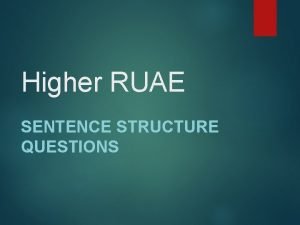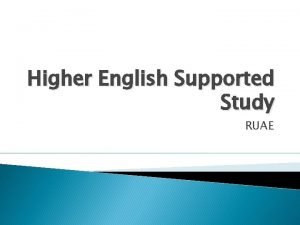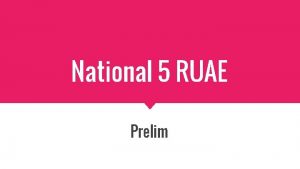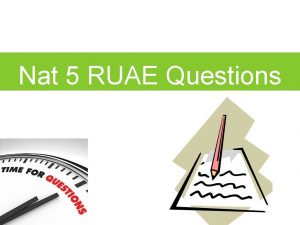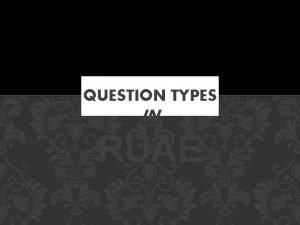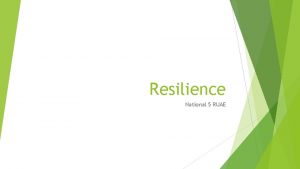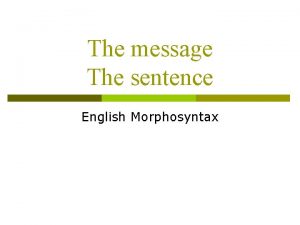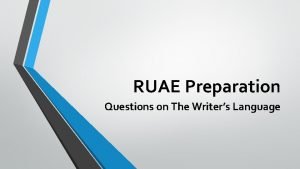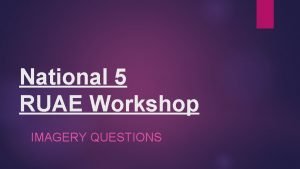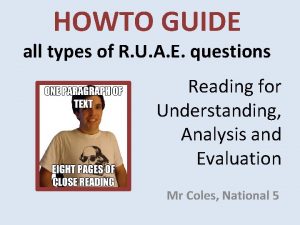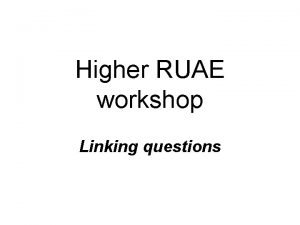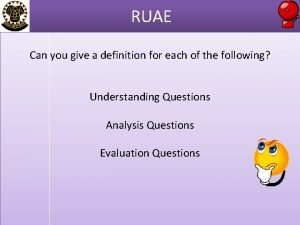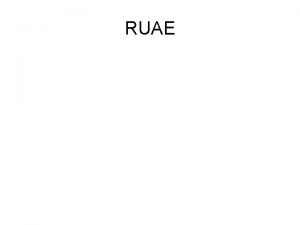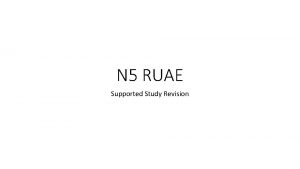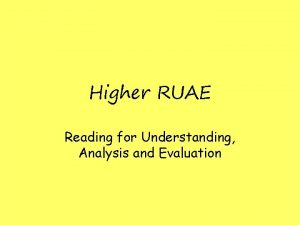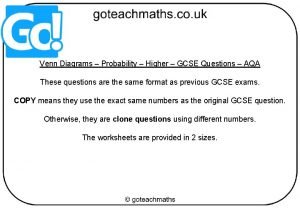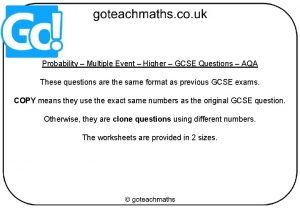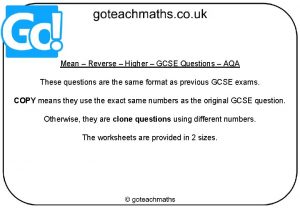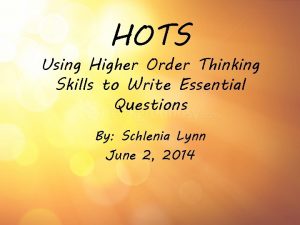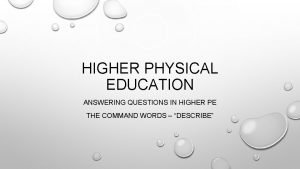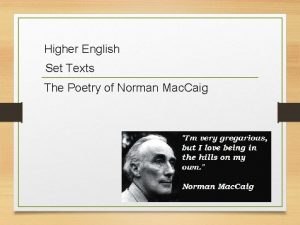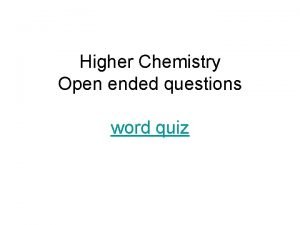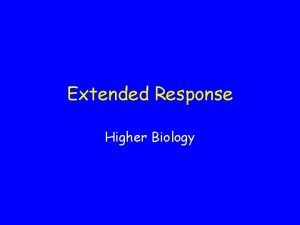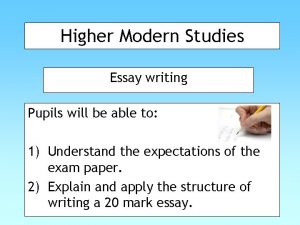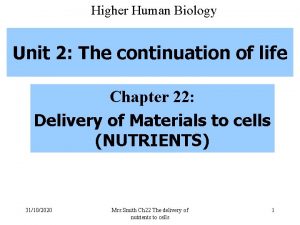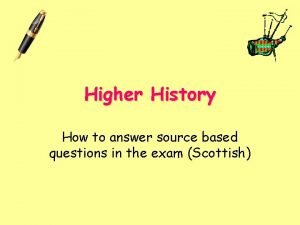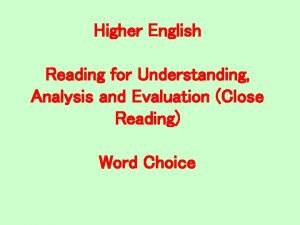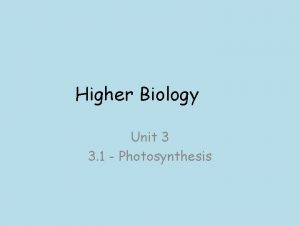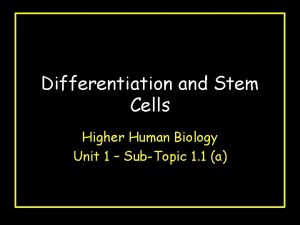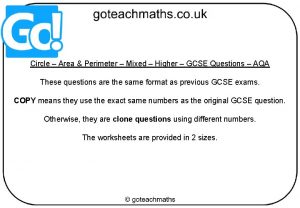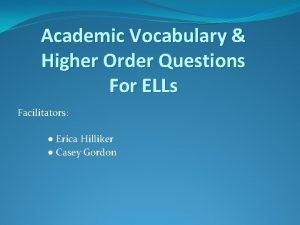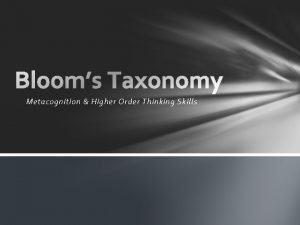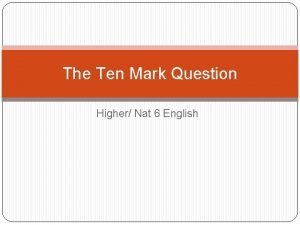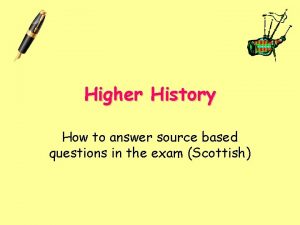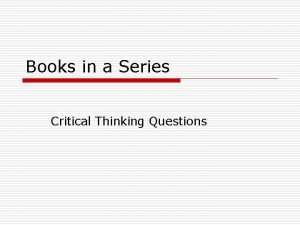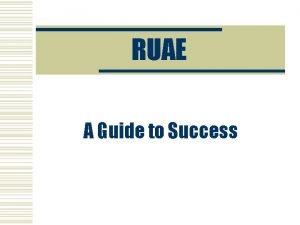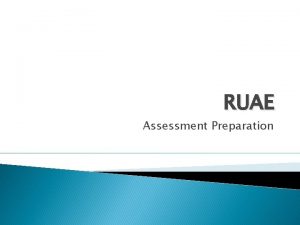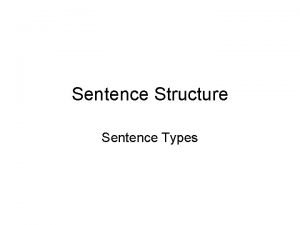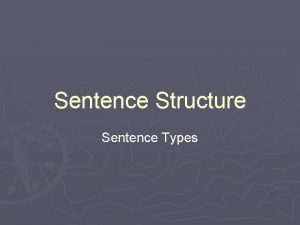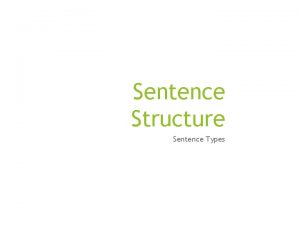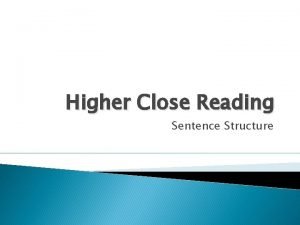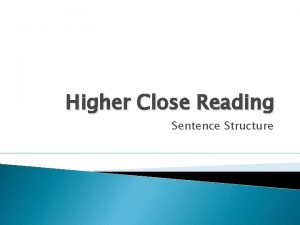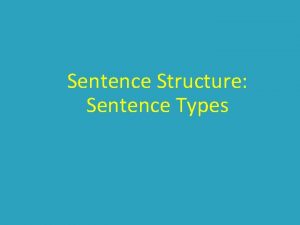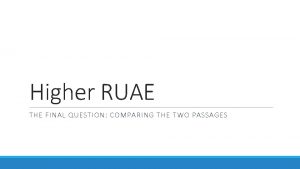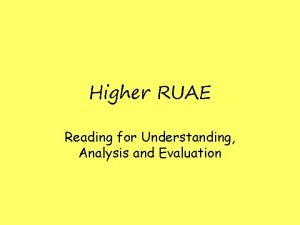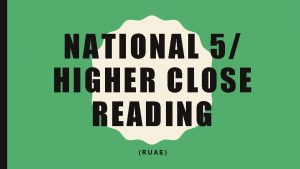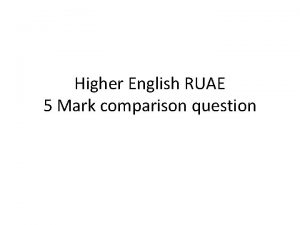Higher RUAE SENTENCE STRUCTURE QUESTIONS In sentence structure
















































- Slides: 48

Higher RUAE SENTENCE STRUCTURE QUESTIONS

In sentence structure questions, you have to explain how the author has used sentence structure to help convey his/her ideas.

For sentence structure questions you will have to do the following when you answer: § Identify which feature has been used (and quote where relevant) § Explain the purpose/function of the sentence structure in the passage (why is has been used) § Explain how the author has used the sentence structure to convey his/her ideas in the passage If you do these steps correctly, you will receive 2 marks.

Features you may be asked about. . . 1. 2. 3. 4. 5. 6. 7. Types of punctuation. Short sentences. Repetition. Lists Climax Anti-climax Minor sentences

1. Punctuation You are likely to be asked about the following types of punctuation: v Exclamation marks. Colons. Semi-colons. Parenthesis. Inverted Commas. Single- dash. Ellipsis. Rhetorical question. v v v v

Exclamation marks ! They can be used to show: Strong emotion (such as surprise, shock, excitement, anger etc). 2. that someone is speaking loudly. 3. that someone is making a command. 1.

Example The second and third day passed, and still my tormentor came not. Once again I breathed as a free man. The monster, in terror, had fled the premises forever! I should behold it no more! My happiness was supreme! The author has used exclamation marks. This is to emphasise the strong emotions of elation and relief felt by the man as he managed to escape the creature.

Colon : The information given after a colon will explain/elaborate on the information that comes before the colon. Thus, the purpose of a colon is to elaborate/explain a point that has just been made.

Example Sub-Saharan Africa is facing a terrifying problem: perpetual drought and famine. “…problem: perpetual…” The author uses a colon to explain the serious issues that people in Africa have to deal with in modern times.

Example Changing Rooms, Tool Stories, Home Front, you know the drill: take three couples, shuffle them with an interior designer/DIY expert/measly budget, see what sticks. “…the drill: take…” The author has used a colon to explain the boring characteristics of home makeover shows.

Semi-colon ; What are they used for?

1. They separate items in a long list. For example: The Governors made the following decisions: to extend the school day to 4 p. m; to introduce water fountains into each classroom; and to encourage pupils to eat healthier food.

2. They often come between two statements which balance one another. For example: There were a king with a large jaw and a queen with a plain face on the throne of England; there were a king with a large jaw and a queen with a fair face on the throne of France.

3. They often come between two statements which are contrasting. For example: On the one hand we have CCTV footage proving that the suspect was, indeed, present at the scene of the crime; on the other hand, we have testimony from his girlfriend saying that he was at home with her.

Example The Governors made the following decisions: to extend the school day to 4 p. m; to introduce water fountains into each classroom; and to encourage pupils to eat healthier food. The author has used semi-colons to list the large number of important decisions that the school governors had made.

Example There were a king with a large jaw and a queen with a plain face on the throne of England; there were a king with a large jaw and a queen with a fair face on the throne of France. “…of England; there were…” The author has used a semi-colon in the middle of the sentence in order to emphasise the similarity between the men and women on the French and English thrones.

Example On the one hand we have CCTV footage proving that the suspect was, indeed, present at the scene of the crime; on the other hand, we have testimony from his girlfriend saying that he was at home with her. “…the crime; on the…” The author has used a semi-colon in the middle of the sentence in order to show the contrast between the reliability of the evidence available concerning the crime.

Parenthesis Used to add extra information in the middle of a sentence that is not vital but adds to the reader’s knowledge and understanding of the author’s ideas.

Parenthesis can be created using commas, dashes and brackets. Commas The oldest man in history, who was from Germany, died at the age of 109. Dashes The oldest man in history-who was from Germany-died at the age of 109. Brackets The oldest man in history (who was from Germany) died at the age of 109.

NB. When writing about parenthesis, you must make sure that you summarise the information inside the parenthesis using your own words!

Example Climate change deniers- of whom there seems to be more and more every day- are experts at wilfully ignoring scientific fact if it contradicts their own biased opinions. “-of whom there seems to be…-” The author has used parenthesis to add extra information to suggest that the number of people who deny that climate change is happening is growing all the time.

Single Dash - Used to add extra information or an explanation at the end of a sentence. NB: When writing about a single dash, you must make sure that you paraphrase the information at the end of the sentence using your own words.

Example As soon as we saw it we wanted to live there- it was as though the villa had been standing there waiting for our arrival. “…-it was as though” The author has used a single dash to explain that, on first sight, they were immediately drawn to the villa and felt that it was a perfect fit for them.

Example At this time passed all the characters of the Spanish streets: the dark veiled women hurrying home from the priest; the Civil Guard whom nobody greets; goldskinned sailors and strutting carters; goat-faced ruffians down from the hills; and old men with the hollow eyes of hermits- their skin stretched thin on chill, ascetic bones. “…-their skin stretched” The author has used a single dash to add an extra piece of description which helps to effectively convey the unattractive appearance of the old men’s faces.

Inverted Commas “ ” To show that someone is speaking (dialogue). OR To suggest that something is not genuine (that something is only “socalled”).

Example Rangers fans are never shy about reminding rival fans that they are the most successful club in the world when it comes to winning domestic trophies. However, they are quick to gloss over the fact that they “won” many of their titles during an era of financial mismanagement and corruption, cheating the taxpayer out of millions of pounds. The author has used inverted commas around the word “won”. This emphasises his belief that Rangers were not genuinely champions and did not deserve their trophies due to their financial dishonesty.

Ellipsis . . . Two main purposes/functions: 1. In the middle of a sentence, they can be used to suggest: That the author is hesitating. That the author is unsure or indecisive. 2. At the end of a sentence, they can be used to: Create a sense of anticipation in the reader. Create a feeling of suspense in the reader.

Example I lay in the darkness. Alone. I could hear footsteps shuffling along the hallway and they didn’t seem human. Heavy, rasping breathing filled my ears. The door opened and a hand appeared. . . The author has used an ellipsis at the end of the sentence. This creates a feeling of suspense in the reader as we want to find out what the figure at the door is and what it looked like.

Rhetorical question Gets the reader involved and engaged in the author’s argument. Encourages the reader to think about what is being said and to agree with the author. Help the author to make a point or put across their argument.

Example What kind of sick and twisted creature would imprison a defenceless and innocent animal in a zoo? There is simply no defence for this barbarity. Human beings do not have a right to abduct these majestic animals from their natural habitat and then lock them up for our own amusement. The author has used a rhetorical question. “What kind. . . in a zoo? ” This gets the reader involved in and think about the author’s argument and encourages the reader to agree with his opinion that zoos are cruel.

2. Short Sentences Why are they used? To emphasise a point. To give impact to what is being said. Short sentences can create a climax or anticlimax (see notes on climax and anti-climax)

Example Some people say decoration is merely about having “nice things” around you in your home. They’re talking nonsense. Home decoration is something that can help to completely transform someone’s mood and overall satisfaction with their life. “They’re talking nonsense” is a short sentence. The author has used it to emphasise that she disagrees strongly with the idea that decoration is something that is superficial and trivial.

Example When I was growing up, my parents would argue interminably. I remember being woken during the night to the sound of sobbing, screams and shouts. The tension at the dinner table was almost unbearable with barely a word being uttered between the two of them, except when asking me about my day at school. Things came to a head one evening when, in the midst of another heated dispute, my mother announced that she didn’t love him any more. And with that, he left us. The author has used a short sentence. “And with that, he left us”. This gives greater impact to the statement where he tells us of the distressing moment when his parents’ relationship finally came to an end.

3. Repetition Sometimes an author repeats a particular word or phrase in a sentence or paragraph in order to emphasise a particular idea or point or argument.

Example We shall fight on the beaches, we shall fight on the landing grounds, we shall fight in the fields and in the streets, we shall fight in the hills. We shall never surrender. The author has used repetition of the phrase “we shall fight”. This is to emphasise to his readers that they must never give up and they must remain strong, brave and determined.

4. Listing This is where an author uses a sentence to list items/ideas which are somehow related. A list is usually created using commas or semi-colons.

Why do authors use listing? To emphasise the amount or number of something. To emphasise the variety or range of something. NB: A list can also build up to a climax or anti-climax (see notes on these).

Example There is a very real risk involved if parents expose their children to salty, sugary, fatty, saturated and addictive foods. “…salty, sugary, fatty…” The author has used a list to emphasise the many reasons why the food that children are given might not be good for their health.

5. Climax Why would an author build up to a climax? To give greater impact to an idea, point or argument. To give greater emphasis to an idea, point or argument

How is an author able to build up to a climax? Short sentences. One-sentence A list. paragraph.

Example When I got home that night it was already after eight, so I was pretty tired. All I wanted to do was have a bath and go to bed, but my as soon as I entered the house I sensed something was wrong and knew that I could forget my plans for an early night. There was a pile of CDs lying on the floor in the hall and doors that were normally closed during the day were wide open. Walking into the living room and switching on the light only confirmed what I already knew. I’d been burgled. “I’d been burgled” is a short sentence which creates a climax at the end of the paragraph. This emphasizes and adds impact to the shock felt by the author when he switches on the light and realizes that he has, in fact, been the victim of a burglary in his home.

Example In a long and distinguished career, he had played for many clubs: St. Johnstone, Hibernian, Celtic, Arsenal and even the mighty Real Madrid. The author has used a list to build up to a climax. He does this to emphasise the number of different teams the man played for and to add impact to the fact that he played for one of the world’s biggest clubs.

6. Anti-climax An author would usually use an anticlimax to create humour.

How does an author create anti-climax? Short A list. sentences.

Example The very serious and proper looking businessman could not hide his embarrassment and anxiety as the policeman started to rifle though his belongings in full view of a crowd of bystanders. The cop began to empty the contents of the case and place them on a table by his side: a laptop, an i-phone, a Rolex watch, Gucci loafers, Chanel aftershave and a bright pink stuffed hippopotamus. The author has used a list to create an anti-climax. This is to emphasise the number of luxury items that the man had stored in his case and to create humour as the final item is revealed, which is completely different, much to our surprise.

7. Minor Sentences A minor sentence is a sentence which does not contain a verb. They are usually very short.

Why are they used? To create impact. To create suspense. To create an informal effect.

Example As he walked along the beach, something caught his eye, something which looked completely out of place. At once, a feeling of unease crept over him and he knew that something was amiss. The feeling grew stronger the closer he came to the object and he began to wish he had never ventured out this morning. He slowly approached it and examined it closely. A child’s shoe. The author has used a minor sentence. “A child’s shoe”. This adds impact to the shocking moment that the man finds out what the object actually is and creates suspense in the reader as we want to know why it is there.
 Ruae question types
Ruae question types Higher english ruae sentence structure
Higher english ruae sentence structure Higher english ruae
Higher english ruae How to answer in your own words questions national 5
How to answer in your own words questions national 5 Own words questions
Own words questions Higher english ruae question types
Higher english ruae question types National 5 ruae
National 5 ruae Ruae higher english
Ruae higher english Summarzer
Summarzer Short definition of sentence
Short definition of sentence Language questions ruae
Language questions ruae How to answer an imagery question
How to answer an imagery question U word
U word Linking sentence examples
Linking sentence examples Link question nat 5 english
Link question nat 5 english Ruä
Ruä What is ruae
What is ruae Ruae revision
Ruae revision Ruae techniques
Ruae techniques Humorous tone
Humorous tone Addicted to shopping ruae
Addicted to shopping ruae Ruae
Ruae Higher probability questions
Higher probability questions Understanding business management
Understanding business management Ratio higher gcse questions
Ratio higher gcse questions A bag contains 30 discs 10 are red and 20 are blue
A bag contains 30 discs 10 are red and 20 are blue Reverse mean problems
Reverse mean problems Higher order thinking skills
Higher order thinking skills Higher pe command words
Higher pe command words Higher human biology unit 3 questions
Higher human biology unit 3 questions Basking shark textual analysis
Basking shark textual analysis Higher chemistry questions
Higher chemistry questions Advanced higher biology extended response
Advanced higher biology extended response Higher order thinking skills
Higher order thinking skills Higher modern studies essay examples
Higher modern studies essay examples Vena cava
Vena cava How to answer source based questions in history
How to answer source based questions in history Advanced higher biology unit 2
Advanced higher biology unit 2 Costa's levels questions
Costa's levels questions Higher english close reading
Higher english close reading Unit 3 higher biology questions
Unit 3 higher biology questions Higher human biology unit 1 questions and answers
Higher human biology unit 1 questions and answers Area and perimeter gcse exam questions higher
Area and perimeter gcse exam questions higher Higher order thinking questions for vocabulary
Higher order thinking questions for vocabulary Metacognition bloom's taxonomy
Metacognition bloom's taxonomy Psychomotor domain objectives examples in lesson plan
Psychomotor domain objectives examples in lesson plan How to answer 10 mark higher english questions
How to answer 10 mark higher english questions Higher history how fully model answer
Higher history how fully model answer Maniac magee higher order thinking questions
Maniac magee higher order thinking questions
